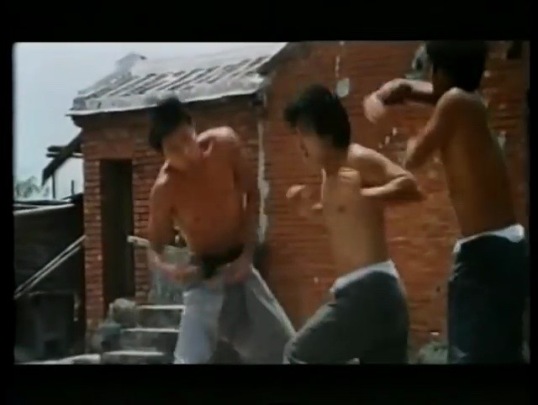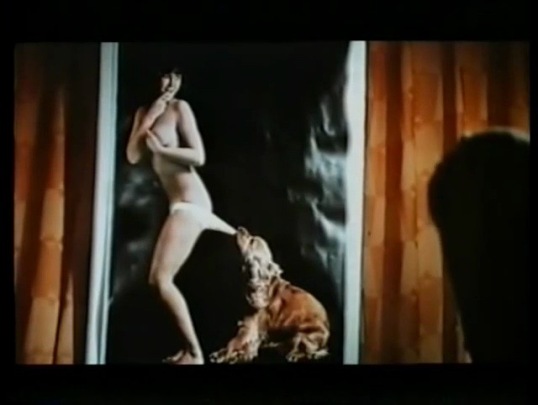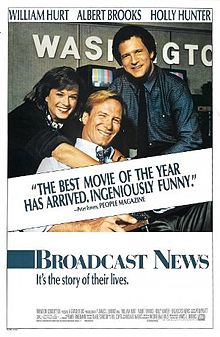The movie is also called Bruce Lee Against Supermen. By that they mean Bruce Li Against 80 Minutes Of Your Life. I really should have been watching something else.
The movie begins with a car chase. Get used to that cause it will happen a lot. This time it’s a police car chasing a couple of criminals. The criminals see that the police are catching up. They are carrying a bag full of money, which they promptly toss out the window. A man and a woman find the money, but are surprised by Bruce Li dressed as Kato.
Why is he dressed like Kato? Who knows? Once a battle after the credits is done, he won’t do it again for the whole movie. There will be a mention of The Green Hornet who I’m pretty sure is two guys dressed like Supermen. Kato takes the couple to his car and drives them away to the police station.
Now the film cuts to the opening credits. There are flies all over them. I’m not sure why. Later we’ll see flies on the Superman uniforms of the Supermen who might be The Green Hornet in this movie.
After dropping the couple off at the police station we see Kato drive away. He doesn’t get far before he appears to have trouble with his tire. After getting out he is attacked from behind.
One thing immediately clear is that not only is Bruce Li not as good an actor as Bruce Lee, but not as good a fighter either. However, everyone else is worse than him in this movie.
After Bruce Li dispatches with them, it cuts to one guy in a suit strangling another guy in a suit. The guy being strangled tells him The Green Hornet did it. That’s when it cuts to some newspapers to tell us that Dr. T has invented a way to refine food from petroleum by-products. He has been invited by the Arabs so he is going to travel to the middle east with his daughter. Then we get to see the Supermen who might be The Green Hornet.
They also have this glowing ball.
Sadly Burt Reynolds doesn’t talk to them through it. Instead, it flashes, and a printer spits out something we can’t read. If you watch this movie, then I hope you enjoy this shot of the Supermen because you won’t see them again in uniform till the very end of the film.
That’s when we cut to the bad guys talking to a guy who is willing to pay big bucks for the bad guys to get Dr. T’s formula. He is willing to pay a lot of money. Now we cut to the “Middle East”
No joke. That’s supposed to be an Arab. That Chinese guy right there is supposed to be an Arab. You might be wondering what he sounds like. He sounds like a Chinese stereotype. I think he is trying to do a Middle Eastern accent, but it’s hard to tell. I seriously doubt they cared. Now the movie cuts to Will Our Heroes Be Able to Find Their Friend Who Has Mysteriously Disappeared in Africa? (1968) as they take Dr. T out to a dig site.
When they arrive at the site they hand the doctor some ore. He suddenly has an attack, but is okay once his daughter gives him some medication. Then he takes a good long look at the ore. We get nice closeups of the ore. We get a zoom shot on her dropping a liquid on the ore. We get a zoom shot on the doctor looking through a magnifying glass at the ore. Once that padding of the movie is done, the daughter decides to go swimming.
This is when the movie decides it’s time to show us the daughter swimming around naked. Oh, and we see the bad guys spying on her, but it’s really just so we can see her naked. Will they actually say anything? Nope. She just gets dressed, then cut to an airplane landing.
Now we watch a man cross the street for a minute or so before hailing a cab to pad the movie out some more. Then we cut to fighting.
We don’t know what they are fighting about at first, but who cares! They’ve got 80 minutes of your life to take away so some of it might as well be mildly entertaining. It turns out they were just practicing. We find out…
this guy in red needs help protecting Dr. T and his daughter. I’m quite sure it’s Bruce Li, but I’m not sure if he was one of the Supermen at the beginning or not. Doesn’t matter because in the next scene Dr. T is getting kidnapped and shoved in a car. In a car that’s passing, the two guys above spot the car and give chase. A long slow car chase.
Back in the movie the car chase is still happening with a needlessly crazy angle…
that doesn’t add anything to the film.

Right now a boxer is finding out that winning the fight doesn’t keep him from his fate he didn’t know was coming. (The Set-Up, 1949)
After a four minute slow speed car chase our two heroes pretend to be lying on the road to stop the kidnappers. They take them by surprise and a fight breaks out.
I call that kick, the Dolemite. That’s where you just place your foot near their face and they pretend to get hit.
After three minutes of fighting we cut to this guy…
who is ordering a sniper. Then we cut to who I assume is Bruce Li and Dr. T’s daughter walking around.
Then they walk around some more.
After three minutes of walking around we cut to a shot of a building. For reasons that I don’t know, a guy who I assume is still Bruce Li walks up to a little girl and somebody takes a shot at him. He grabs the little girl and they hide behind a pillar. She is carrying a little wind up toy. Bruce winds it up and places it on the street. He leaves the girl to make a run for the building.
He runs to the top of the building where the shot came from. Then he throws a rope over the edge of the building and rappels down the side of it to pad the movie out some more.
Then he gives chase.

Right now this woman is in the middle of having explained to her what happened last year. (Last Year at Marienbad, 1961)
After seven and a half minutes of him chasing him, the two fight.
It cuts to this shot during the fight.
After leaving the audience wondering Where’s Waldo? it then cuts back to the two of them on the top of the building where the bad guy falls to his death.
Back to the phone guy, and we learn that “The Green Hornet” is a real problem for him. But after listening to the unseen person on the other end, he says he’ll just get Superman. Maybe that’s this next guy who now does his part to pad this movie out more.
After he spends a minute of doing his martial arts/calligraphy routine, we cut to ninjas flipping.
No really, random ninjas inserted that flip around for 10 seconds. Maybe Godfrey Ho did this part of the movie.

Right now you’re looking at a very famous scene of a historical event that didn’t take place where the film says. (Battleship Potemkin, 1925)
Now a guy and a girl speak in Adam and Eve talk before padding the movie out with sex.
We cut to the doctor getting kidnapped again before cutting back to sex. Now the doctor’s daughter runs on the street, bumps into a guy, and he takes her to the sex scene. Then we see more sex to pad the film out some more. Daughter bursts in and immediately starts a cat fight with the girl. After one tries to hold the other’s head under a running shower, we cut to this.
While they have to wait for “Green Hornet”, the doctor is getting tortured by bad camera effects.
Right now that’s how I feel about the rest of this review. Let’s cut through this: chase, fight, pointless hostage scene, fight, chase, fight, pointless hostage scene, fight, fight, fight, chase, and movie!
Make that the middle finger, and you have what I felt the film was trying to tell me. You didn’t miss anything. It’s all padding. The chase scenes go on forever, the fighting is boring, and the plot is almost non-existent. Please go watch the other movies and TV Shows I mentioned rather than subjecting yourself to this. Well, that is except for the one just below this text. That documentary was awful.








































